Tejas Networks Bundle
How Has Tejas Networks Transformed the Indian Telecom Landscape?
Founded in Bengaluru in 2000, Tejas Networks has emerged as a pivotal player in India's telecom sector. This Indian telecom equipment company has been instrumental in designing and developing cutting-edge optical networking solutions. Their initial vision focused on creating intelligent network technologies capable of high-speed data transfer and resilient traffic management.
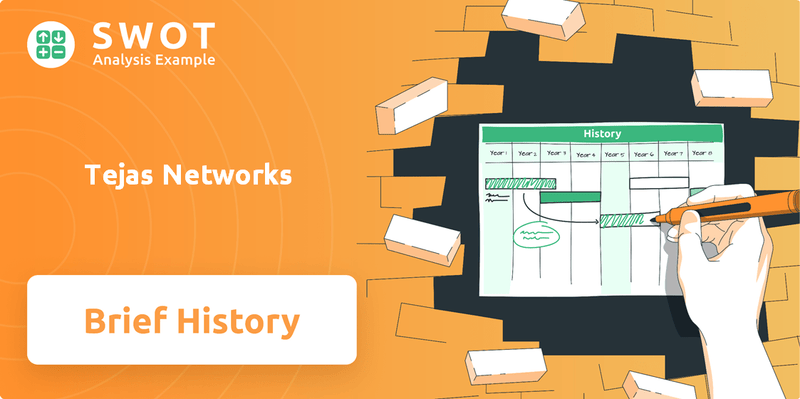
Tejas Networks' commitment to indigenous innovation has solidified its role within the 'Atmanirbhar Bharat Abhiyan'. With a presence in over 75 countries, the company serves a diverse clientele and has demonstrated impressive financial growth. For a deeper dive into their strategic positioning, consider exploring the Tejas Networks SWOT Analysis.
What is the Tejas Networks Founding Story?
The story of Tejas Networks, a key player in the Indian telecom sector, began in 2000. Founded by Sanjay Nayak and Arnob Roy, the company aimed to capitalize on the growing demand for advanced telecom solutions. Their vision was to develop intelligent network technologies, positioning themselves as a significant force in the optical networking space.
With initial backing from Gururaj Deshpande, the founders set out to build an independent Indian telecom entity. This decision, solidified in 2002, marked a pivotal moment, steering the company towards its current trajectory. The early focus was on creating proprietary hardware for optical signal transmission, establishing a foundation for future growth.
The early days saw the formation of a 15-member founding team, fueled by an initial investment of ₹21 crore from Deshpande, Sycamore, and ASG Omni. The founders and employees initially held a 50% stake, showing their commitment to the venture. This early investment was crucial in establishing the company's infrastructure and enabling it to start its operations in the competitive telecom equipment market.
From its inception, Tejas Networks focused on innovation in optical networking, aiming to become a key telecom equipment provider.
- Founded in 2000 by Sanjay Nayak and Arnob Roy.
- Initial funding included ₹21 crore from investors.
- The founders chose to build an independent Indian company.
- Kumar N. Sivarajan, a specialist in optical fiber, joined the team.
For a deeper understanding of Tejas Networks' strategic positioning and target market, you can refer to this analysis: Target Market of Tejas Networks.
Tejas Networks SWOT Analysis
- Complete SWOT Breakdown
- Fully Customizable
- Editable in Excel & Word
- Professional Formatting
- Investor-Ready Format
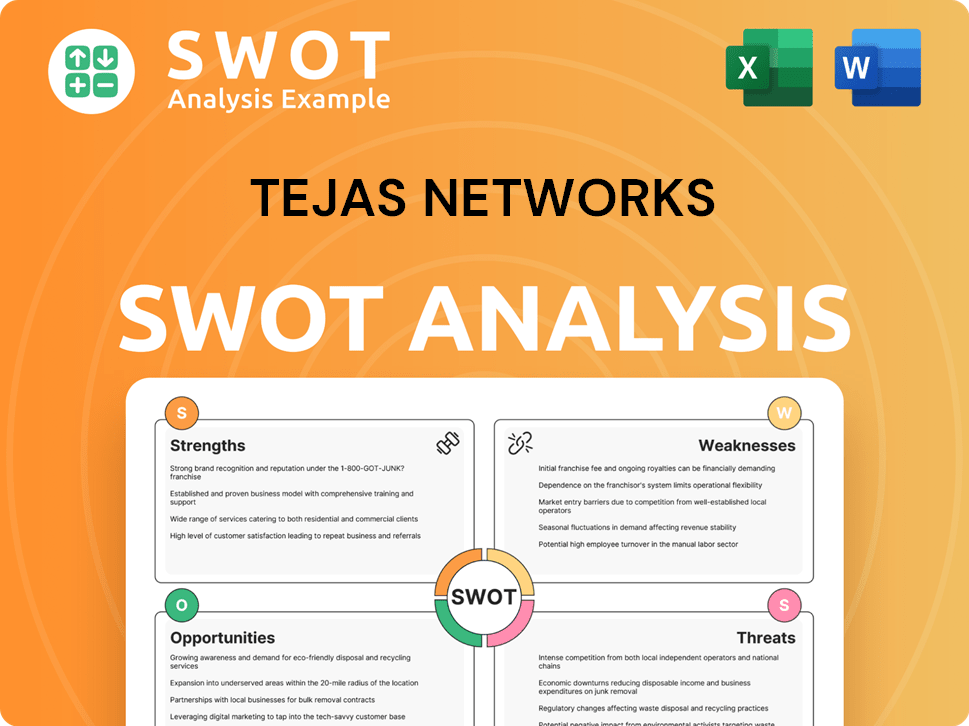
What Drove the Early Growth of Tejas Networks?
The early phase of Tejas Networks history centered on developing its intelligent network technologies, marking its entry into the optical networking and telecom equipment sectors. By 2002-2003, the Tejas Networks company had secured ten customers, laying the foundation for its expansion. A significant milestone was achieved with an order from TATA Power Company Limited in 2001, followed by Railtel Corporation of India Limited in 2004, which propelled its growth within the Indian telecom market.
In January 2005, Tejas Networks received $15 million in its third funding round from Battery Ventures, which was used for technology development and international partnerships. This investment was crucial for expanding its product portfolio and market reach. The company also obtained ISO 9001:2000 Certification in 2004, which enhanced its credibility and operational standards.
The company went public on the BSE and NSE in June 2017, with a valuation of ₹2301 crore. This IPO, which raised ₹7.77 billion, enabled the company to invest in research and development and international sales. By 2018, Tejas Networks had customers in over 70 countries, showcasing its global footprint.
In July 2021, Panatone Finvest, a subsidiary of Tata Sons, acquired Tejas Networks, increasing its stake to 55.5% by 2020-2021 through an investment of ₹1850 crore in different tranches. This acquisition provided substantial growth capital and strengthened its market position. As of January 31, 2025, Tejas Networks had 2,355 employees.
The company's revenue for FY24 stood at ₹25,356 million, marking a 145.3% increase compared to FY23, indicating strong financial growth. This growth reflects the company's robust performance and strategic initiatives in the telecom equipment sector. The company continues to focus on expanding its market share and presence in key regions.
Tejas Networks PESTLE Analysis
- Covers All 6 PESTLE Categories
- No Research Needed – Save Hours of Work
- Built by Experts, Trusted by Consultants
- Instant Download, Ready to Use
- 100% Editable, Fully Customizable
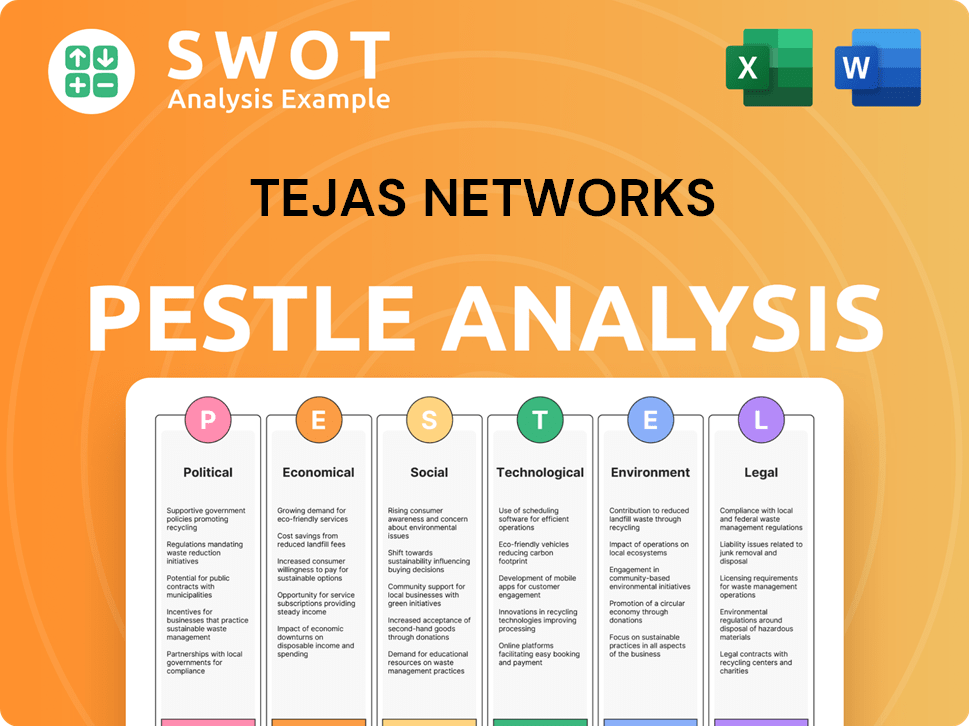
What are the key Milestones in Tejas Networks history?
The history of Tejas Networks is marked by significant milestones, including overcoming setbacks and achieving technological advancements. The company's journey showcases its resilience and commitment to innovation in the Indian telecom sector.
| Year | Milestone |
|---|---|
| 2009 | Experienced a revenue dip due to the bankruptcy of its largest customer, impacting financial performance. |
| 2017 | Achieved a pivotal moment with its Initial Public Offering (IPO), becoming the first listed player in the optical networking equipment space in India. |
| 2022 | Successfully demonstrated an end-to-end indigenous 4G/5G network, showcasing advanced 4G and 5G macro Radio Access Network (RAN) equipment. |
| 2023 | Secured a ₹7,500 crore order from BSNL for the supply of 100,000 4G and 5G sites, with deliveries completed by May 2025. |
| 2024 | Secured a three-year contract with Vodafone Idea Ltd. (VIL) to enhance its backend network in December. |
| 2025 | Signed a strategic technology partnership with NEC Corporation of Japan for joint development of advanced wireless technologies and a joint go-to-market strategy in February. |
| 2025 | Received ₹123.5 crore in March under the design-led PLI scheme for FY2024, with eligibility for ₹367.7 crore PLI for 9M FY2025. |
Tejas Networks has consistently focused on innovation, developing numerous IPs in telecom networking. The company has filed over 480 patents, with a focus on technologies like radio resource management and wireless networking.
In 2022, the company demonstrated a complete indigenous 4G/5G network. This included advanced 4G and 5G macro Radio Access Network (RAN) equipment and multi-terabit optical aggregation.
Tejas Networks introduced the world's first ultra-converged broadband product (TJ1400 UCB). This product combines 4G/5G Radio RAN, fiber broadband access, and packet-optical transport technologies.
The company has built a strong intellectual property portfolio. Over 480 patents have been filed, focusing on areas such as radio resource management and wireless networking.
A strategic technology partnership with NEC Corporation of Japan was established. This partnership focuses on joint development of advanced wireless technologies.
Received ₹123.5 crore under the design-led PLI scheme for FY2024. The company is eligible for ₹367.7 crore PLI for 9M FY2025.
Secured a three-year contract with Vodafone Idea Ltd. (VIL). This contract aims to enhance the backend network infrastructure.
Despite its successes, Tejas Networks faces challenges, including financial fluctuations and market dynamics. The company reported a consolidated net loss of ₹71.80 crore in Q4 FY25, highlighting the impact of market conditions.
Tejas Networks reported a consolidated net loss of ₹71.80 crore in Q4 FY25. This was primarily due to the absence of a one-time exceptional gain booked in the previous year.
The company had a moderate order book position of ₹1,019 crore as of Q4 FY25. This situation provides limited revenue visibility.
The company is exposed to foreign exchange rate fluctuation risks. This can impact financial results and operational planning.
Revenue from operations increased by 44% year-on-year to ₹1,907 crore in Q4 FY25. This indicates strong market demand.
The Indian telecom market is competitive, and the company faces challenges from competitors. This requires continuous innovation.
The company is forming strategic partnerships to strengthen its market position. These partnerships are essential for long-term growth.
To learn more about the company's core values, you can read about the Mission, Vision & Core Values of Tejas Networks.
Tejas Networks Business Model Canvas
- Complete 9-Block Business Model Canvas
- Effortlessly Communicate Your Business Strategy
- Investor-Ready BMC Format
- 100% Editable and Customizable
- Clear and Structured Layout
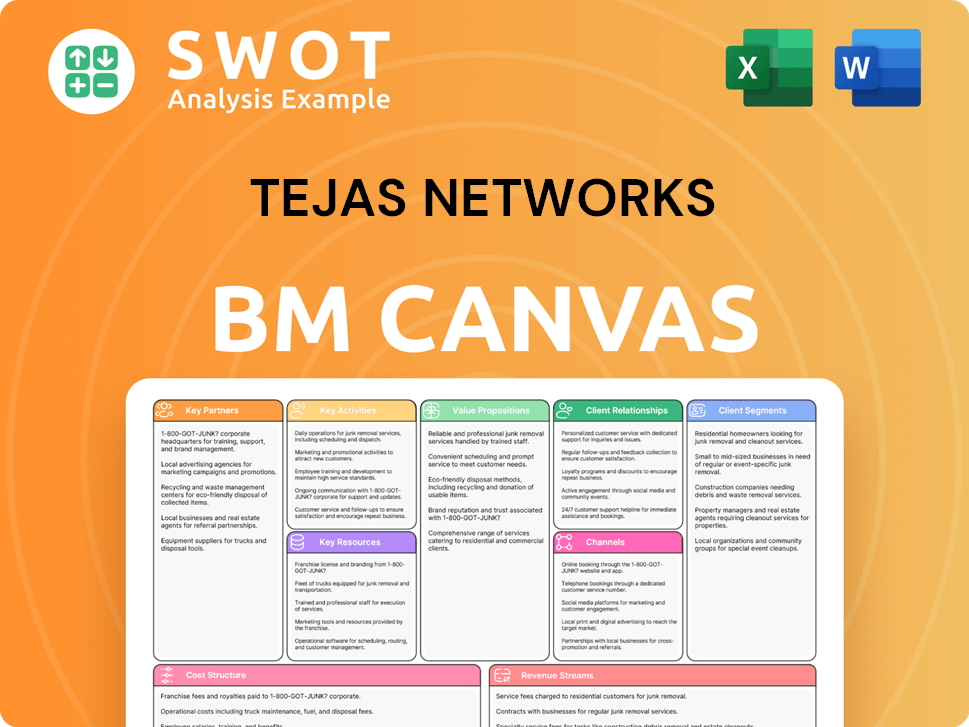
What is the Timeline of Key Events for Tejas Networks?
The journey of Tejas Networks, from its inception to its current standing in the telecom sector, showcases significant milestones and strategic shifts. Founded in Bengaluru in 2000 by Sanjay Nayak and Arnob Roy, the company has navigated challenges and capitalized on opportunities to establish itself as a key player in the Indian telecom market. Key events include securing early orders, obtaining certifications, and attracting substantial investments, alongside adapting to market dynamics and technological advancements.
| Year | Key Event |
|---|---|
| 2000 | Founded in Bengaluru by Sanjay Nayak and Arnob Roy. |
| 2001 | Procured order from TATA Power Company Limited. |
| 2004 | Received ISO 9001:2000 Certification. |
| 2005 | Secured $15 million in third-round funding from Battery Ventures. |
| 2008 | Company name changed to Tejas Networks Limited. |
| 2009 | Faced a significant challenge with the bankruptcy of Nortel, its largest customer. |
| 2017 | Went public on BSE and NSE with an IPO valuing the company at ₹2301 crore. |
| 2020-2021 | Tata Sons invested ₹1850 crore, acquiring a 37% stake, which later increased to 55.5%. |
| March 2022 | Acquired 64.4% stake in Saankhya Labs for $37.5 million. |
| October 2022 | Successfully demonstrated an end-to-end indigenous 4G/5G network. |
| August 2023 | Won a ₹7,500 crore order from BSNL for 4G/5G network deployment. |
| December 2024 | Secured a three-year contract with Vodafone Idea Ltd. |
| February 2025 | Entered into a strategic technology partnership with NEC Corporation of Japan. |
| March 2025 | Received ₹123.5 crore under the telecom PLI scheme for FY2024. |
| May 2025 | Completed delivery of telecom gear for 100,000 BSNL 4G/5G sites. |
The company is aiming for stronger growth in FY26 by expanding its product portfolio and targeting larger markets. This involves enhancing its 5G capabilities, including support across multiple bands and advanced 5G massive MIMO radios. Expansion also includes strengthening optical transport products with 800G and 1.2T DWDM systems.
The company is well-positioned to benefit from the Indian government's 'Atmanirbhar Bharat Abhiyan'. It expects a healthy inflow of orders in both wireless and wireline products from domestic and international clients. Future triggers include BharatNet Phase 3 and Kavach order wins expected towards the end of FY25.
Analyst predictions for the share price in 2025 range from ₹837.00 to ₹969.05, driven by increasing demand for telecom infrastructure and domestic manufacturing incentives. The company's leadership emphasizes favorable global market trends and strong projected growth across all product segments.
Ongoing strategic initiatives and industry trends like 5G, edge computing, and AI/ML are shaping its future trajectory. The company is expanding its router and FTTx solutions to benefit from rising broadband demand. The acquisition of a proven 4G/5G Core platform is a key step in enhancing its competitiveness.
Tejas Networks Porter's Five Forces Analysis
- Covers All 5 Competitive Forces in Detail
- Structured for Consultants, Students, and Founders
- 100% Editable in Microsoft Word & Excel
- Instant Digital Download – Use Immediately
- Compatible with Mac & PC – Fully Unlocked
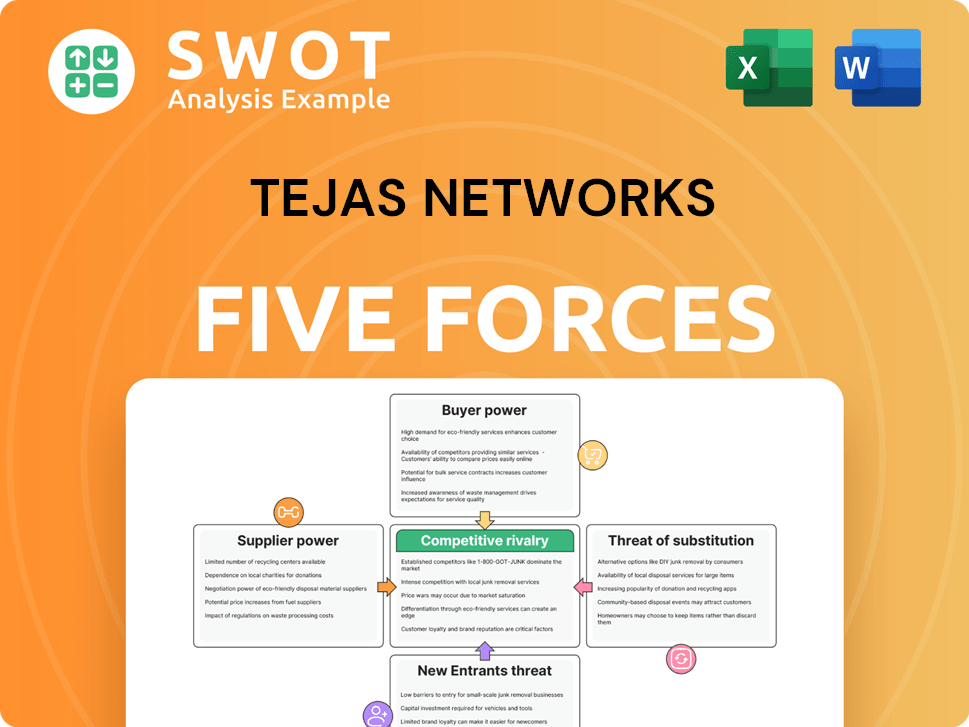
Related Blogs
- What is Competitive Landscape of Tejas Networks Company?
- What is Growth Strategy and Future Prospects of Tejas Networks Company?
- How Does Tejas Networks Company Work?
- What is Sales and Marketing Strategy of Tejas Networks Company?
- What is Brief History of Tejas Networks Company?
- Who Owns Tejas Networks Company?
- What is Customer Demographics and Target Market of Tejas Networks Company?
Disclaimer
All information, articles, and product details provided on this website are for general informational and educational purposes only. We do not claim any ownership over, nor do we intend to infringe upon, any trademarks, copyrights, logos, brand names, or other intellectual property mentioned or depicted on this site. Such intellectual property remains the property of its respective owners, and any references here are made solely for identification or informational purposes, without implying any affiliation, endorsement, or partnership.
We make no representations or warranties, express or implied, regarding the accuracy, completeness, or suitability of any content or products presented. Nothing on this website should be construed as legal, tax, investment, financial, medical, or other professional advice. In addition, no part of this site—including articles or product references—constitutes a solicitation, recommendation, endorsement, advertisement, or offer to buy or sell any securities, franchises, or other financial instruments, particularly in jurisdictions where such activity would be unlawful.
All content is of a general nature and may not address the specific circumstances of any individual or entity. It is not a substitute for professional advice or services. Any actions you take based on the information provided here are strictly at your own risk. You accept full responsibility for any decisions or outcomes arising from your use of this website and agree to release us from any liability in connection with your use of, or reliance upon, the content or products found herein.